by Tom Gaylord
Writing as B.B. Pelletier
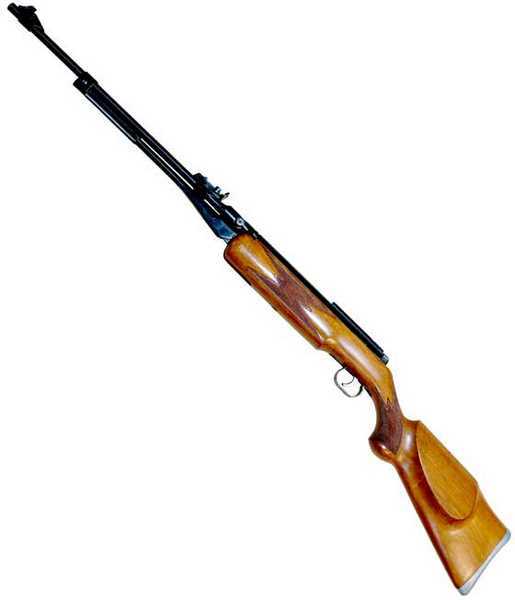
BSF S54 target rifle.
This report covers:
- BSF
- The S54
- Trigger
- Three variations of the S54
- Two calibers
- Hang tag
- Underlever cocking
- Loading tap
- Summary
I’m starting a report on the BSF S54 target rifle today. I reviewed this rifle 4 years ago, but I want to look at it more thoroughly this time.
BSF
Bayerische Sportwaffen Fabrik (Bavarian Sporting Weapons Manufacturer) or BSF, as it was known, operated for several decades, both before and after World War II. They were based in Erlangen, Germany, a suburb of Nuremberg. The guns they made were approximately equivalent in quality to Dianas, though in some respects like power they were ahead for a few years. It was BSF that first broke the 800 f.p.s. barrier with their model S55/S60/S70 breakbarrel. I group those models because they were all the same except for their stocks — kind of like the S54 we are looking at today.
They remained at the forefront of the airgun horsepower races throughout the late 1970s and into the early ’80s until the Beeman R1 buried the field. Then, in the late 1980s, they quietly left the market. I have reported on their models 55, 70, and even on the S54 in the past, but that was before the historical airgun section began.
I have often marveled at the irony of me discovering precision adult airguns while living in Erlangen, Germany, from 1974 to the end of 1977. I bought a Diana model 10 target pistol (in Rothenberg ob der Tauber) and started my fascination with airguns while living in the same town where BSF was headquartered! However, in a most ironic turn of fate, I hadn’t a clue they were there until many years after I had returned to the United States. Oh, the humanity!
The S54
The S54 was the flagship rifle from BSF. It wasn’t their most powerful, but it was certainly their fanciest! It’s 45.5 inches long with a 19-inch barrel. The pull is 13.75-inches, which is very long for a target rifle. And, the big gun weighs 8 lbs. 12 oz. The stock is round and full in all its dimensions. You know you’re holding something when this one is in your hands!
Trigger
There are many interesting things I want to tell you about BSF airguns, and I guess I will begin with their triggers that are a novel approach to manufacturing cost controls in the 1950s. They used plates stamped from sheetmetal and riveted together in a block in place of machined parts. As long as the stampings were precise, the product was good. They weren’t the only airgun company doing this, though. It was a popular way of avoiding costly machining operations.
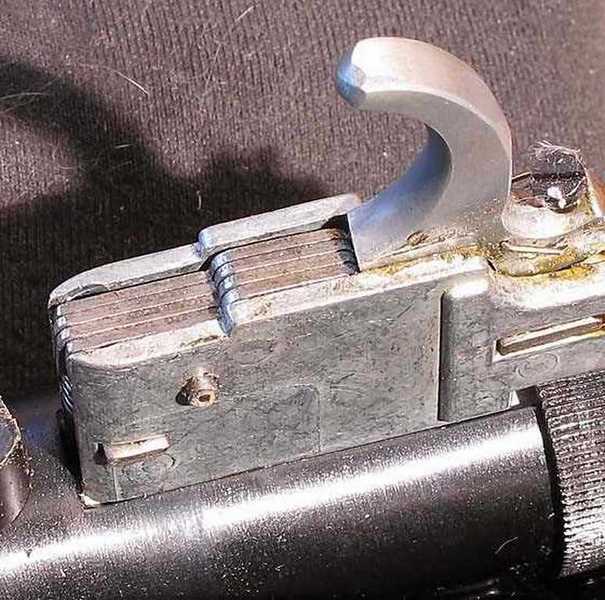 This trigger is from a BSF S70, but it is the same as the trigger on the S54. Four stamped plates riveted together take the place of one machined piece of steel.
This trigger is from a BSF S70, but it is the same as the trigger on the S54. Four stamped plates riveted together take the place of one machined piece of steel.
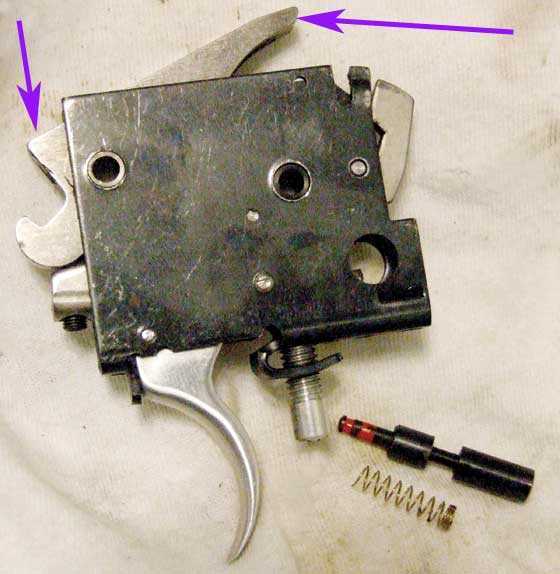
The Rekord trigger has a machined piston release (arrows). It’s a more flexible trigger than the one found in BSF rifles, but it costs much more to build.
One problem with BSF triggers is they get lighter as they wear in. This apparently never stops because I have had triggers so light that the guns fired on their own without touching the trigger blade. That means the sear is slowly slipping while the gun is cocked. Dr. Beeman cautioned tuners to not use moly on triggers, and, in the case of BSF triggers, I must agree.
Three variations of the S54
Before I get to the next difference about the S54 you need to know that there are three variations of the same model. The basic rifle is called the Standard and is recognized by its plain wood stock that may be walnut and has a European finger groove running along both sides of the forearm. It has no checkering or cheekpiece and the comb is straight. The sights are sporting sights like you see on my rifle at the top of this report. I will talk about them more in a future report. The rest of the barreled action is identical to that of the other two variations.

The BSF S54 Standard was a plain-Jane sporter.
The second variation is called the Bayern, which means Bavaria in German. Its walnut stock is hand-checkered at the pistol grip and on both sides of the forearm. The comb is straight and there is a Bavarian-style raised cheekpiece on the left side of the butt. The sights are the same sporting sights as those seen above. This would be the deluxe version of the sporting model.

The BSF S54 Bayern was the deluxe variation of the sporting rifle.
The third variation is called the S54Match. That’s the gun I am testing for you. It has a walnut stock with a raised cheekpiece on the left side of the butt and a Monte Carlo comb. The pistol grip and forearm are both hand-checkered and on the forearm the area covered by checkering is larger than on the Bayern. That may have varied over the years, as I have seen Bayerns with the same amount of checkering as this rifle has, and that includes the one just pictured. The pistol grip of the Match rifle is rounded on the bottom. The butt plate is aluminum, where the other two have plastic plates.
The most outstanding feature of the Match model, however, is its diopter rear sight. I had a diopter on my other S54. It had a large rear disk that was about 2 inches in diameter. But there is another diopter that has an exceptionally large disk. It is perhaps 3 or more inches in diameter. That one attracts attention from all shooters. I once had a guy tell me he paid as much for that sight as he did for his entire rifle. My Match rifle is missing its diopter sight, so I’m on the hunt for one.
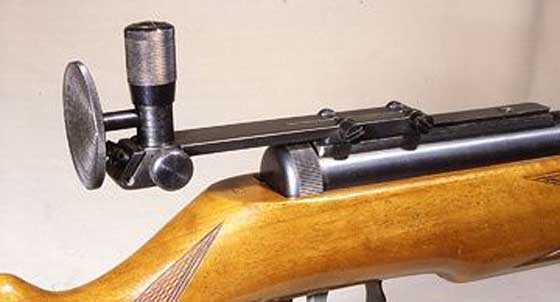
The Match S54 came with this aperture sight.
The Blue Book of Airguns says that the Bayern model came with the rear aperture sight, but I haven’t seen any BSF literature to support that. It was probably an option and perhaps some retail company catalog showed it that way, but BSF literature puts the target sight on the Match model, only.
The Blue Book also lists a Deluxe model that has the identical features of the Match gun shown here. But I will show you proof that BSF just referred to this as the Match model. I don’t know where the Deluxe model comes in, as I have never seen any original BSF literature referring to it. It may have been something that happened near the end of the run in the mid-1980s.
Two calibers
Here’s another strange fact. The S54 Match was produced in both .177 (4.5mm) and .22 (5.5mm). Given the timeframe of production —1950 to the end of the company in the late 1980s — .22 caliber was common here in the U.S., but in Europe it was never as popular as .177, and was certainly never used for a target gun! Oh, there was a Webley Osprey target model in .22 caliber, but like the S54, it wasn’t a serious competition model. The first S54 I owned was an S54 Match in .22 caliber. The one shown here is a .177.
Hang tag
Here is my proof that BSF calls this model the Match and not a Deluxe. I have the original hang tag that’s serial-numbered to this gun! That’s rarer than the big diopter sight!
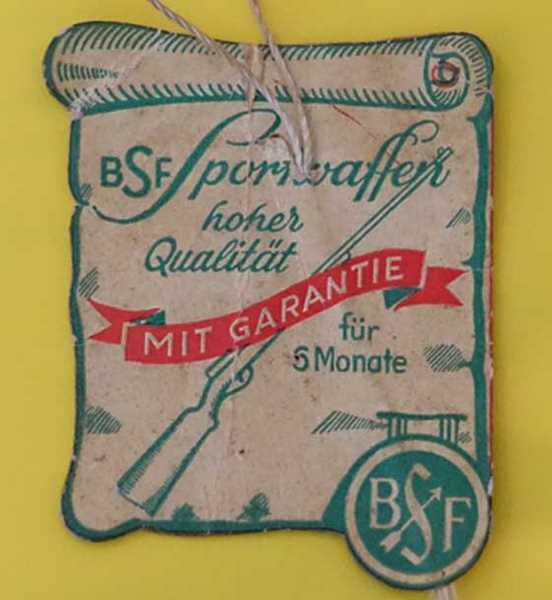
My rifle came with the original hang tag.
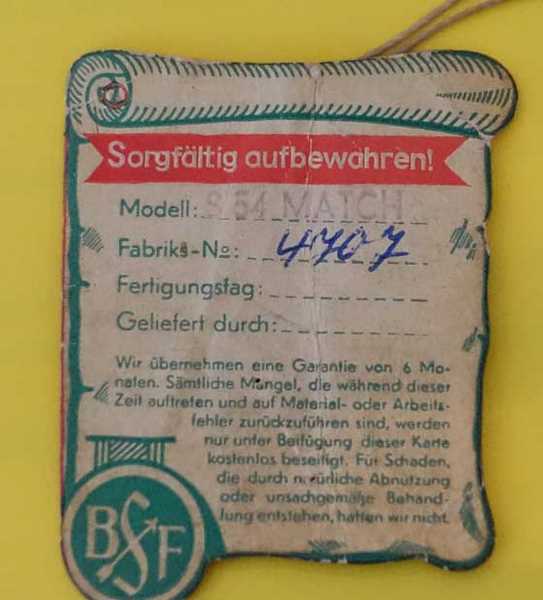
The hang tag is serial-numbered to my rifle. Notice it is called an S54 Match.
Underlever cocking
You can see from the first picture that the S54 is an underlever rifle. Its underlever is formed from a thick piece of sheet steel that appears machined until you examine it closely. It’s actually folded into a long round rod. That does save weight over a solid steel rod — a lot, in fact. The handle of the lever is knurled around its circumference and is spring-loaded. To cock the rifle you pull back on the handle to release it from a fixed ball catch in front. The rifle then cocks like any other underlever.

When its cocked the underlever comes down this far.
Loading tap
There is no safety nor any anti beartrap device, so hang onto that underlever all the while its down. However, your fingers won’t be in any danger when you load because the S54 has a loading tap. It doesn’t open automatically when the rifle is cocked like many taps do. It must be opened manually to load a pellet. Once open simply drop a pellet into the tap nose-first then pull the lever back to rotate it closed. The rifle is then loaded.
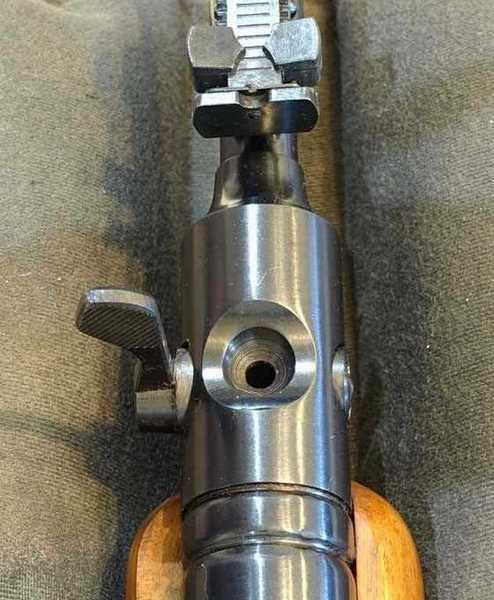
Drop a pellet nose-first into the loading tap, then rotate the tap closed to load the rifle.
Serious target rifles don’t use loading taps. When a gun with a tap fires, the pellet is blown into the rifling by the force of the air coming from the compression chamber through the tap. That’s not conducive to accuracy, so target rifles don’t usually use one. The Haenel models 311, 312 and 550 all have taps, but they are not considered to be serious 10-meter target rifles.
Summary
There is a lot more to tell but I will weave the rest into the future reports. This big BSF S54 is a real wonder in the airgun world. As reader RidgeRunner would tell you, the quality simply exudes from the gun. The last time I tested it I promised to shoot it with an optical sight, so when we get to that point it will receive the UTG Micro Reflex dot sight that Pyramyd AIR now carries.
I make no promises but I’m thinking about a possible tuneup. This one has a little vibration and way too much velocity, so I may just look inside.

B.B.
I really enjoy reading about, and the pictures, of these high-quality airguns from the past.
This ol’ gal is a real beauty! Looking forward to reading more about her. =>
Take care & God bless,
dave
P.S. While past guns are cool, I’m constantly reminded that, to use your phrase,
“We are living in the Golden Age of Airguns!”
Hence, I am looking forward to more replica airgun versions of the great guns from history.
If not for your blog, I would not have known to look for a replica Colt, and they are cool.
Broken in, at 5 meters from a rest, this one can hit the bottom of a fired .38 Special case every time.
So thanks again for all the info you provide. =>
Davemyster,
Nice shooting! Very cool gun you have!
Doc
B.B.
Great series and nice report! If you are not supposed to use Moly grease on stamped trigger sears, what are you supposed to use?
Hopefully your series will include a bunch of reports on Hanel. A company that I know nothing about.
Thanks,
-Yogi
Yogi,
Plain lithium grease would have been sufficient.
Siraniko
B.B.,
A fascinating look at an airgun from yesteryear. Seems like the manufacturers back then were actually selling accuracy! Making their offerings look like 10 meter rifles even though they weren’t. Going to the point of selling accessories to make the rifle look the part. Looking forward to the rest of the test.
Siraniko
PS:
Section Trigger last paragraph last sentence: “Dr. Beeman cautioned to not (us/users/tuners not to?) use moly on triggers, and, in the case of BSF triggers, I must agree.”
Section Three variations of the S54 last paragraph third sentence: “I don’t know where the Deluxe model comes in, as I have never seen and (any?) original BSF literature referring to it.”
Section Loading tap: last paragraph last sentence: “The Hanel (Haenel?) models 311, 312 and 550 all have taps, but they are not considered to be serious 10-meter target rifles.”
Siraniko,
Wow! You really earned your pay with this one!
Thank you,
B.B.
B.B.,
A nice revisit of the ol’ girl. Looking forwards to more reports on this one.
Good Day to you and to all,………. Chris
Looking at what John Walter wrote in the early-mid 1980s, when BSF were still in production, there seem to be five distinct variants of this rifle.
Basic S54, plain stock with grasping groove.
S54N (nussbaumschaft – walnut stock) – the same design of stock as above, but checkered on the pistol grip.
And the ‘B’ and ‘M’ versions you then describe. He includes a BSF parts diagram showing four separate stocks. These are what might be called the classic, long-established BSF production.Shortly before its final collapse the S54 Sport was introduced, which is similar to the ‘B’ but with a much deeper pistol grip and fore-end, and no checkering. (A similar stock was applied to the S70, to create not the S70 Sport but the S80.)
A point regarding loading taps – I always though auto-opening taps were the exception, you seem to be suggesting otherwise (” it doesn’t open automatically when the rifle is cocked like many taps do”) or am I misunderstanding this phrase.
Regards,
Iain
Lain,
I will have to look at what Walter said. Thank you,
B.B.
Hi Everyone, I found this site/forum whilst looking for info on this air rifle, and I want to thank the author, Tom, and all the other contributors for the valuable information. I recently came across a BSF S54 that was amongst a house full of belongings from someone that passed away. The rifle’s rather outdated looks appealed to me, as I wanted something I could hang on the wall in a “hunter’s lounge” at our cottage that wouldn’t look like an air rifle. I was able to buy the rifle for a low price, and it’s in very good condition for its age, with just a few signs of wear and use.
The serial number on the loading port lever is 356, so I assume it is from the first year of production. Does anyone know the year it was first introduced? I read that it was some time in the ’50’s.
The stock is the standard version with the finger grooves in the forend and no raised cheekpiece/comb, but the pistol grip is checkered (nicely too!), as Iain mentions above. I am certain that the stock is stained beech though, with the characteristic golden flecks that this wood has showing through.
If it’s helpful, I am happy to upload some pictures!
Greetings from Switzerland!
Peter
Peter,
Per the Blue Book, the company was founded in 1935 and made a few air guns before 1935. WWII came along and they resumed production in 1948. As for your model, it only says discontinued in 1986 and call it the Sport Model “with plain stock”. It says it was made in both .177 and .22.
Chris
Suipete,
Not many monitor and reply through the RSS. Nobody will mind if you post your question in the latest blog posting where a whole lot of more knowledgeable people can answer your question.
From this page: https://forum.vintageairgunsgallery.com/bsf/bsf-miscellaneous/ it appears that the S54 underlever dates from 1950’s and is encountered with 4 stock variations, Standard, Nussbaumschaft, Bayern and Match.
Welcome to the blog!
Siraniko
Hello and thanks for the advice and info. I’ll post a pic of the stock here just in case anyone else searches for this rifle one day. Mine is .177. The stock has the SILE mark stamped into the wood.
I’ve changed my mind about the stock being beech, after taking the action off to clean it. The wood inside reminds me of the old match air rifles and small bore rifles I used to own, decades ago. Definitely walnut!
BB,
You are so right about the quality. Usually when I see stamped metal I turn my nose up. Look at the joint of the compression tube to the breech. That’s impressive.
I do like that rear sight. Something I just noticed about the front sight when looking at your old report is that the blade is removable and can be replaced, most likely intended to have various styles to suit the shooter. Nice touch.
RR,
I have always believed that there must have been different inserts for the front sight. too. A squared-off post would be ideal.
B.B.
BB,
Interesting report on the S54; I like the fact that it was available in .22 caliber.
I hate to correct you on a Monday morning, but the Haenel 312 uses a sliding breach and the 550 has a bolt for loading. I have a 550 if you would be interested in a guest blog sometime.
Paul in Liberty County
Paul,
Thanks. I also thought the 312 had a sliding breech, but the Blue Book said different. Also the 550.
B.B.
Morning B.B.,
Today’s installment was very interesting and informative as always. You mentioned that production guns like BSFs have stocks checkered by hand. Have you or any of the readers checkered a stock by hand? This is something I’m interested in learning to do, along with making custom stocks. Since I live on Cape Cod, MA, there are ship building shops around, and I have a source for beautiful Teak wood. Does anyone know if Teak is a good, stable wood for stocks?
Thanks!
Will,
Tomorrow.
B.B.
BB,
That rifle sure is a looker. Are you certain it‘s only 45.5“ long though? It looks like you could polevault with that thing! It reminds me of (still on the Star Wars theme) the Tusken Raider/Sand People‘s sniper rifles 🙂
What was the technological advance that allowed the 800 f.p.s. barrier to be broken? Was it just the introduction of synthetic seals, or was there more to it than that?
Bob,
I’m pretty sure that lengthening the piston stroke was the biggest advance. BSF did it and when FWB followed with a rifle that only took 25 lbs. to cock, the airgunning world was wowed. FWB used a synthetic piston seal, but BSF used leather.
B.B.
BB,
That’s interesting. So, were air rifles in general short-stroked before the velocity race began in the late seventies?
The only short-stroked air rifles one seems to hear about nowadays are the HW35 and some tuned versions of the HW80/R1. The latter of which is basically just a HW80 turned back into a HW35! 🙂
Was long-stroking frowned upon before the late seventies? Perhaps because it was thought the slower lock time would lead to greater hold sensitivity and thus be detrimental to accuracy?
Bob,
It wasn’t frowned upon so much as it just wasn’t done. The older breakbarrels often break down to just 90 degrees before they are cocked.
B.B.
Bob
I need to watch more of the old movies and oay attention more.
Those sand sniper guns are cool. Wonder what they shot. If indeed there was such a gun.
GF1,
They look like the old muskets that were prevalent with the desert tribes. These I am sure fired an energy beam.
R.R.,
They got R2D2 with a pulse and he had blue electric arcs all around him! He then fell over and a puff of smoke arose from his internals : 0 The little Sand Crawler people got him next and repaired him for resale to LUKE SKYWALKER…
shootski
Shootski
Yep I do remember that. Poor R2D2.
Shootski,
That was the Jawas (Sand Crawler people) that stunned and captured R2D2, not the Sand People! 🙂
The Sand People knocked C3PO off of a cliff when attacking Luke, if I recall correctly, breaking off C3PO’s arm.
Bob Ryan,
I’m certain you are right! It has been years since I watched the movie and DVD!
I guess it will be fun to watch next bad weather evening.
shootski
RR
If you look at that fella on the left in the picture. I say that’s a laser sight sitting on top of his gun.
How about that. A laser beam sight for a laser beam hit.
Wonder what the hold on the laser sight would be like to the laser beam hit at different distances. I’m thinking not like the ballistics of a bullet.
RR,
Extract from a Star Wars fan site: “The Tusken Cycler was the standard projectile weapon used by the Tusken Raiders of Tatooine in ranged combat. The cycler was an older design of rifle and fit into the slugthrower class, firing solid shots enveloped in energy, not blaster bolts. The weapon emitted a unique sound when fired, rather like a cross between a blaster and a musket.”
It looks very reminiscent of Ottoman era arquebuses, which were the sniper rifles of the 16th and 17th century Muslim world.
Bob,
https://www.liveauctioneers.com/item/69820192_antique-camel-hunting-flintlock-musket-with-bone-inlay
RR,
That is just plain bizarre looking. So long and slender. It makes you think of the thought (at the time) and the evolution of stock design since. The inlay and outside mech. is amazing to look at. Hand wrought details. It does however look in pretty rough shape. No description was noted, that I recall. I wonder the age? I wonder the worth?
Chris
RR,
Then again,… this site might be one of those that is like,… ” If you have to ask what the price is,… maybe it is better to move on.”,…. type of site? 😉
Chris
GF1,
Those guns are known as Tusken Cyclers in the Star Wars expanded universe. There are supposed to be a type of bolt action slug gun.
Bob
Interesting.
B.B.,
The BSF literature said that the 54 Bayern model was “Supplied normally with the micrometer peep sight”. Guess that means if they felt like it you might get one? LOL! See here:
https://forum.vintageairgunsgallery.com/bsf/bsf-model-54-air-rifle/#post-2072
Kevin,
Thank you. I just learned something!
B.B.
B.B.,
In a discussion on another forum last October
(https://www.gatewaytoairguns.org/GTA/index.php?topic=149380.0 )
some guy named “jmars” referenced one of your earlier BSF reports:
“There is at least one write up on Pyramyd air’s website on BSF guns:
/blog/2008/03/bsf-55n-part-1/
“Here is some info on BSF/HW. I stole this on a Google search and do not know who originally wrote it.”
B.S.F. “BAYERISCHE SPORTWAFFENFABRIK”
Previous manufacturer located in Erlangen, Germany. Previously imported by Kendell International located in Paris, KY, and by Beeman Precision Arms under the Wischo label. B.S.F. (Bayerische Sportwaffenfabrik) is the manufacturer for airguns marketed with B.S.F., Bavaria, and Wischo trade names. B.S.F. was founded in 1935 and produced a few airguns before the pressures of WWII took over. Production began again in 1948 and put an emphasis on solid, simple construction. The Model S54 remains as a classic example of solid, elegant construction for a sporter air rifle. B.S.F.´s own production was generally sold under the Bavaria label. The Wischo Company of Erlangen (founded by Egon Wilsker), one of Europe´s leading gun distributors, distributed large numbers, especially to Beeman Precision Airguns in the USA, under the Wischo label. The collapse of their British agent, Norman May & Co, in 1980 resulted in the dismissal of most of the 130 workers. The Schütt family sold the business to Herbert Gayer, who reorganized the company and the production process. However, this was not enough to prevent further decline of the company. It was then purchased by the Hermann Weihrauch Company in nearby Mellrichstadt in the late 1980s. By incorporating some HW design and cosmetic features and parts, a surprisingly good line of upper economy level airguns was developed to supplement the top-of-the-line regular HW models. Weihrauch manufactures versions of B.S.F. models for Marksman (Marksman Models 28, 40, 55, 56, 58, 59, 70, 71, 72, and 75).
___________
Out of curiosity, I typed that whole first sentence into google, and it sent me here:
http://www.wehrmacht-awards.com/forums/showthread.php?t=602256
…where “robs” gives attribution for the BSF paragraph to the Beeman Blue Book.
History is cool, and the history of old guns especially so. =>
Looking forward to the rest of these BSF reports,
dave
It’s interesting to look at what John Walter said about the firm in the four editions of his ‘The Airgun Book’, published in 1981, 82, 84 and 1987.
First edition – “Production of barrel-cocking and underlever designs, sturdy but somewhat unsophisticated, recommenced in 1948 and still continues. Many guns are encountered with the Wischo brand-name …”, after which the classic product range of the S20 pistol, S54 and junior, intermediate and adult break barrels are described.
Second edition – “With the sudden demise of Norman May & Co, BSF’s British agency, the future of BSF has become less clear and fears for the company’s future have been widely – but perhaps prematurely – expressed.” There is no suggestion, though, that anything has actually been discontinued and the product range he describes is unchanged.
Third edition – “In 1980, the sudden demise of the company’s British agents, Norman May & Co, caused such a crisis that BSF’s future looked very uncertain and the majority of the workforce of 130 was laid off. The Schutt family ultimately sold the business to Herbert Gayer, under whose management the product range has been radically refined.” From what Walter actually describes, the S20 and some of the smaller rifles have gone, and a new design of stock appeared on the 54 and 70 (to make the 80).
Fourth edition – the whole entry on the company has been reduced to a paragraph, now very much a footnote on the airgun scene. “Though Herbert Gayer purchased BSF from the Schutt family in 1982, even radical surgery failed to save the company. The guns have not been encountered in Britain since the early 1980s. … BSF’s demise is a shame; together with Weihrauch, the company represented last of the traditionalists in the German airgun industry.”
There is no mention of the actual purchase by Weihrauch, or the designs living on, but in this edition in particular Walter is now writing very much with regard to the British market – was this where these guns were intended for?
Regards,
Iain
lain,
Thank you for this information. I only own two of Walther’s books — The first edition and the third edition. You have expanded my knowledge of what Walter said.
B.B.
The second edition is very similar in layout and content to the first, with only minor updates and illustrating this gun rather than that.
The fourth is really quite different. His introduction is much more a view of the British airgun scene as he saw it, both the guns themselves – tuning and custom guns becoming much more common – and legislation, discussing the 12 ft.lb limit for example.
The main directory section though is split into two for the first time, part one comprising major manufacturers with an introduction and overview of each firm, and each gun described separately. So there are for example entries for Air Arms, BSA and Webley, some of the Spanish firms, Diana (the German firm) and Weihrauch, Crosman and Daisy. It seems odd now perhaps that Haenel are covered in some detail, but perhaps at the time they happened to be regularly available.
Part two covers lesser firms in a paragraph or two each, ranging from UK customising firms, recently closed manufacturers such as BSF and Milbro (the directory is not historical beyond this), and firms in current production but making only one or two designs, or that simply aren’t common on the UK market – the trio of Italian SSP pistols, for example, by Air Match, FAS and Fiocchi, get a paragraph each, as do the simple break-barrel springers of FB Record, imported but falling off it seems in popularity. ‘Chinese state factories’ actually fall into this category, at that time, which might seem incredible now but I can remember when getting a batch of those cheap break-barrel springers (Pioneer, or Tiger?) imported was noteable but by no means regular.
In addition, CO2 guns are more or less ignored, whether plinkers by Crosman or 10m match by FWB and Walther due to being on FAC at the time.
Regards,
Iain
lain-UK,
I enjoyed your comment and in depth information. More so, I enjoy that it is a perspective that comes “from across the pond”. Here, we can get about anything we can afford,… power wise,… whereas in the U.K.,… the 12 fpe. rule is in effect,… unless a license to obtain something more powerful is acquired. That is a perspective not often discussed, (other than,…. “Man!,… I am sure glad that I don’t live there!”). So the whole concept is a bit foreign, but further thought/education/perspective is always welcomed.
I recently purchased a Daystate Red Wolf. in .25 HP,… a SR no less. Love it. In doing so, I have been a somewhat regular on the Daystate Owner’s Club site and have a new appreciation of what it is like over there from the poster’s comment’s, which are largely Euro based.
So,.. all in all,…. I hope you stick around as I very much enjoy new perspectives.
Chris
lain,
I remember when CO2 guns came off FAC, the Crosman 600s tripled in price overnight! They have relaxed some, but didn’t go back to where they were.
B.B.
“Oh the humanity!” That’s what the radio announcer said when the Hindenburg caught fire while mooring in N.J.
I moved to San Rafael in 94′, and I was so disappointed to find the Beeman store had recently closed.It was empty but for a few guns, a guy was trying to make a go of it, but a legend was gone.Thats where I finally got to handle an Eliminator. That gun cannot be decocked, it must be fired after cocking? Oh, the humanity..
Rob
Rob,
You win my historian’s award of the day.
B.B.
Dear Mr. BSF
I’m skeptical of your warning against moly due to my understanding that it’s application to mating surfaces can significantly reduce, if not eliminate, the metal-on-metal friction and resultant wear which otherwise lightens the trigger. Thanks for any feedback.
John
B.B,,
Interesting report on an interesting rifle.
But the final photograph (above the summary) of the tap shows part of a rear sight. Are you going to discuss the sight in another report? It appears the rear sight element is exchangeable? Or is that just for adjustability? Should have read your earlier report!!!! Duh! No need to do more work!
Off current Blog topic but of interest to anyone who collects, owns, shoots or repairs Rusty guns tools and other ferous items that might rust.
http://www.big45metalcleaner.com
I have no personal experience with this product but find it interesting enough to purchase some; unless you or the Blog Readership have had a first hand BAD experience with it. I have included a review thread link below:
https://www.rimfirecentral.com/forums/showthread.php?t=381902#/topics/381902?page=1
I hoped for more review information from our rimfire friends ; )
shootski
shootski,
Yes, I plan to cover the sights next. The rear sight element just flips over — I think. With the large diopter I doubt they put anything more into the sporting sight.
B.B.
The topic of when to machine and when to stamp is an interesting one. Of course, it depends on the part. A dedicated 2″ pipe line can be 200′ long from coil to finished pipe. That might be a severe underestimate. A piece put into a press is often stamp cut first, on another machine. Not all parts can be finished in 1 die/press, but must go through several. Hardened press dies are not cheap to make. Now we have laser cutters and multi axis/tool machine centers that are CNC controlled.
All in all,…… an interesting topic.